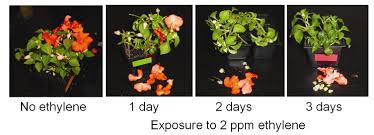Ethylene (C₂H₄) is a natural plant hormone that plays a crucial role in the ripening and aging processes of fruits and vegetables. While it is essential for the natural maturation of produce, excessive ethylene can lead to premature ripening, spoilage, and reduced shelf life.
Proper storage of fruits and vegetables is essential for maintaining freshness, extending shelf life, and reducing waste.

Effects of ethylene on plants
This article will explore how to optimize produce storage by effectively removing ethylene, using various methods and technologies.
Different fruits and vegetables produce and respond to ethylene in varying degrees. Here is a chart that categorizes common produce based on their ethylene production and sensitivity:
| COMMODITY | RECOMMENDED TEMPERATURE SETTING | ETHYLENE PRODUCTION RATE | ETHYLENE GENERATION | ETHYLENE SENSITIVITY |
| FRESH FRUIT & VEG. | °C | |||
| Apple (non-chilled) | 1.1 | 30 | VH | H |
| Apple (chilled) | 4.4 | 40 | VH | H |
| Apricot | -0.5 | 31 | H | H |
| Artichoke - Globe / Jerusalem | 0 | 32 | VL | L |
| Asian Pear | 1.1 | 34 | H | H |
| Asparagus | 2.2 | 36 | VL | M (Toughness) |
| Avocado -California | 3.3 | 38 | H | H |
| -Tropical | 10 | 50 | H | H |
| Banana | 14.4 | 58 | M | H |
| Beans -Lima | 0 | 32 | L | M |
| -Snap / Green | 7.2 | 45 | L | M |
| Belgian Endive | 2.2 | 36 | VL | M |
| Berries -Blackberry | -0.5 | 31 | L | L (Mold) |
| -Blueberry | -0.5 | 31 | L | L (Mold) |
| -Cranberry | 2.2 | 36 | L | L (Mold) |
| -Currents | -0.5 | 31 | L | L (Mold) |
| -Dewberry | -0.5 | 31 | L | L (Mold) |
| -Elderberry | -0.5 | 31 | L | L (Mold) |
| -Gooseberry | -0.5 | 31 | L | L (Mold) |
| -Loganberry | -0.5 | 31 | L | L (Mold) |
| -Raspberry | -0.5 | 31 | L | L (Mold) |
| -Strawberry | -0.5 | 31 | L | L (Mold) |
| Breadfruit | 13.3 | 56 | M | M |
| Broccoli | 0 | 32 | VL | H (Yellowing) |
| Brussel Sprouts | 0 | 32 | VL | H |
| Cabbage | 0 | 32 | VL | H |
| Cantaloupe | 4.4 | 40 | H | M |
| Cape Gooseberry | 12.2 | 54 | L | L |
| Carrots- topped | 0 | 32 | VL | L (Bitterness) |
| Casaba Melon | 10 | 50 | L | L |
| Cauliflower | 0 | 32 | VL | H |
| Celery | 0 | 32 | VL | M |
| Chard | 0 | 32 | VL | H |
| Cherimoya | 12.8 | 55 | VH | H |
| Cherry -Sour | -0.5 | 31 | VL | L (Softening) |
| -Sweet | -1.1 | 30 | VL | L (Softening) |
| Chicory | 0 | 32 | VL | H |
| Chinese Gooseberry | 0 | 32 | L | H |
| Collards | 0 | 32 | VL | M |
| Crenshaw Melon | 10 | 50 | M | H |
| Cucumbers | 10 | 50 | L | H (Yellowing) |
| Eggplant | 10 | 50 | L | L |
| Endive (Escarole) | 0 | 32 | VL | M |
| Feijoa | 5 | 41 | M | L |
| Figs | 0 | 32 | M | L |
| Garlic | 0 | 32 | VL | L (Odor) |
| Ginger | 13.3 | 56 | VL | L |
How it Works: Uses oxidation or adsorption to trap ethylene gas.
Advantages: Easy to use in sachets or filters.
Limitations: Requires periodic replacement and generates chemical waste.
How it Works: Removes ethylene by increasing airflow in storage areas.
Advantages: Simple and cost-effective in open environments.
Limitations: Ineffective in enclosed spaces; energy-intensive in refrigeration units.
How it Works: Adjusts O₂ and CO₂ levels to slow ethylene production.
Advantages: Extends storage life significantly for certain fruits (e.g., apples, pears).
Limitations: Requires specialized equipment and high operational costs.
How it Works: Blocks ethylene receptors in produce, delaying ripening.
Advantages: Effective for certain fruits like apples and avocados.
Limitations: Does not remove ethylene gas itself; limited effect on vegetables.
How it Works: Uses precious metal catalysts (e.g., platinum, palladium) to oxidize ethylene into CO₂ and water at low temperatures.
Advantages:
Highly efficient and long-lasting (continuous ethylene removal with no need for frequent replacement).
Non-toxic and environmentally friendly (does not release byproducts like potassium permanganate).
Works in enclosed spaces (ideal for refrigerated storage, shipping containers, and warehouses).
Limitations: Requires an initial investment in catalytic equipment.
Among the different methods, ethylene removal catalysts offer the best balance of efficiency, longevity, and environmental safety. Unlike passive absorbers that require frequent replacement, catalytic oxidation actively destroys ethylene without producing harmful residues. This makes it an ideal choice for cold storage facilities, food distribution centers, and large-scale fruit and vegetable storage operations.
By implementing ethylene removal catalysts, businesses can:
Extend produce shelf life more effectively
Reduce operational costs over time
Improve storage quality in refrigerated and enclosed environments
Minimize food waste and enhance supply chain efficiency
For long-term ethylene control in produce storage, catalyst-based ethylene removal technology is the superior choice, ensuring consistent freshness and product quality.
The raw material of polyvinylidene fluoride (PVD
Explore the viscosity grades and industrial appl
Discover how to prevent yellowing in textile fin
Contact: Tony Li
Phone: +86-13263299644
Tel: +86-13263299644
Email: sales@ecoviaet.com
Add: No 3 Youyi Road,Tangshan,Huantai,Zibo,China
We chat
